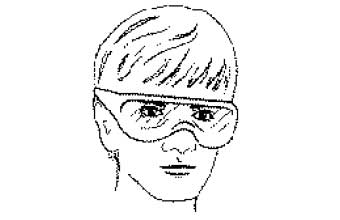Here are some key points:
- Wear the right protective eyewear for your specific job.
- Don’t substitute regular glasses for goggles or safety glasses.
- Act quickly if you get a foreign substance in your eyes.
Eye injuries can be serious.
- Preserving our eyesight is important to us all.
- We put our eyes at risk when we don’t protect them from possible injury on the job.
- It only takes a split second to damage our eyes – either temporarily or permanently.
- Some common eye hazards in the workplace are:
- Small flying objects or particles
- Chemical splashes
- Harmful gases or vapors
- Dusts
How to avoid eye injuries:
- Be alert to any dangers around you.
- Follow all safety procedures.
- Know which types of protective eyewear will protect you while working.
- Wear protective eyewear if there is any doubt your eyes are in danger.
Safety glasses with side shields
- Safety glasses with side shields will help protect your eyes when you are grinding, sanding, mowing, or where there is a chance of small objects being thrown.
- The brow guard and side shields will protect your eyes from hazards that may enter from the top or sides.
- Ask your supervisor if you are uncertain whether safety glasses are adequate for your particular job.
Goggles
- Goggles provide greater protection from liquids, splashes, and dusts than shielded safety glasses.
- But it’s important to be sure they fit tightly against your face.
- Warning:
- Do not wear regular glasses in place of safety glasses or goggles. They won’t adequately protect your eyes. If you wear contact lenses, protective eyewear must be worn over them. Do not wear your contact lenses if you might be exposed to dusts, chemical splashes, or vapors.
Face shield protection
- A face shield alone isn’t enough to protect your eyes. Wear it over safety glasses or goggles, depending on whether vapors or dusts are present.
What to do in an accident
- If you get dust, a wood chip or another small particle in your eye, look down and flush it out with eyewash solution. Use water if eyewash solution is not available.
- If a pesticide gets into your eyes, immediately use a portable eye flush dispenser or call for help if needed to get to an eyewash station.
- Flush your eye with eyewash solution for 15 minutes. Have someone call for medical attention while you are flushing.
- The material safety data sheet (MSDS) or pesticide label will also give you first-aid instructions that you should always follow.
Eye Protection Do’s and Don’ts
Do:
- Check your pesticide label if you don’t know which type of protective eyewear to use.
- Clean dirty lenses and frames.
- Ask for different protective eyewear if the lenses are scratched or damaged.
Don't:
- Wear regular glasses instead of goggles or shielded safety glasses.
- Wait to begin flushing your eyes if something gets in them.
- Forget to check your pesticide label for first aid instructions.
For more resources on how to stay safe on the job, click here.










